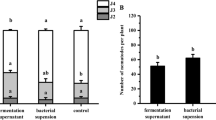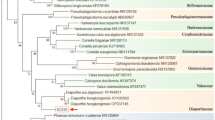Abstract
WHILE fusaric acid has been isolated and identified from culture filtrates of a number of Fusaria, its detection in vivo in diseased host plants has not yet been achieved in order to establish its vivotoxic complicity in wilt diseases1. Recent work of Zähner2 on the detection and estimation of fusaric acid by chromatographic and bioassay techniques suggests the possibility of detection of fusaric acid in vivo in wilting host plants. We have been employing various chromatographic techniques, particularly the circular macro-3 and micro-4 techniques developed by one of us, for the detection and quantitative estimation of fusaric acid, and experienced considerable difficulty in obtaining sharp demarcation of the bands and reproducible R F values to facilitate quantitative estimation. Fusaric acid detected with brom cresol green indicator gives a diffused and ill-defined yellow band in a blue background, possibly due to the poor ionization of the acid. The difficulty was overcome by preliminary conversion of fusaric acid into its copper complex on the filter paper with copper sulphate and irrigating the complex with excess copper with n-butanol/acetic acid/water (4: 1: 5). The quantitative estimation of fusaric acid has been carried out with this technique based on the area method and will be published shortly; we have used the technique for the detection of fusaric acid in vivo in wilted cotton plants.
This is a preview of subscription content, access via your institution
Access options
Subscribe to this journal
Receive 51 print issues and online access
$199.00 per year
only $3.90 per issue
Buy this article
- Purchase on Springer Link
- Instant access to full article PDF
Prices may be subject to local taxes which are calculated during checkout
Similar content being viewed by others
References
Dimond, A. E., and Waggoner, P. E., Phytopathology, 43, 229 (1953). Lakshminarayanan, K., Proc. Indian Acad. Sci., 41B, 132 (1955). Sadasivan, T. S., ibid., 41B, 97 (1955). Sadasivan, T. S., and Subramanian, C. V., J. Indian Bot. Soc., 33, 162 (1954). Subramanian, C. V., Curr. Sci., 24, 144 (1955).
Zähner, H., Rev. App. Mycol., 34, 169 (1955); Phytopath. Z., 22, 227 (1954).
Lakshminarayanan, K., Arch. Biochem. Biophys., 49, 396 (1954).
Lakshminarayanan, K., Arch. Biochem. Biophys., 51, 367 (1954).
Lakshminarayanan, K., Proc. Indian Acad. Sci., 40B, 167 (1954).
Author information
Authors and Affiliations
Rights and permissions
About this article
Cite this article
LAKSHMINARAYANAN, K., SUBRAMANIAN, D. Is Fusaric Acid a Vivotoxin?. Nature 176, 697–698 (1955). https://doi.org/10.1038/176697a0
Issue Date:
DOI: https://doi.org/10.1038/176697a0
This article is cited by
-
Effect of culture filtrate containing fusaric acid of Fusarium oxysporum f. sp. ciceris on defence enzymes in chickpea
Indian Phytopathology (2024)
-
Effect of fusaric acid on the leaf physiology of cucumber seedlings
European Journal of Plant Pathology (2014)
-
Strains ofFusarium vasinfectum VI. pathogenicity andin vivo production of pathogen factorst
Proceedings / Indian Academy of Sciences (1979)
-
Influence of fusaric acid on circadian leaf movements of the cotton plant, Gossypium hirsutum
Planta (1978)
-
Respiration under pathogenesis
Proceedings / Indian Academy of Sciences (1969)
Comments
By submitting a comment you agree to abide by our Terms and Community Guidelines. If you find something abusive or that does not comply with our terms or guidelines please flag it as inappropriate.



